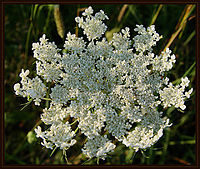Queen Anne's Lace: Difference between revisions
Jump to navigation
Jump to search

imported>Jessica Pierce m (copy edit, mostly formatting (italics for Latin names)) |
mNo edit summary |
||
| (5 intermediate revisions by 5 users not shown) | |||
| Line 1: | Line 1: | ||
{{subpages}} | |||
[[Image:Queen Anne's Lace.jpg|thumb|200px|Queen Anne's Lace|{{Queen Anne's Lace.jpg/credit}}<br>Queen Anne's Lace]]Properly, "Queen Anne's Lace" is the common name of the edible wild carrot plant ''[[Daucus carota]]''. Because of its large, composite, white flowers, however, the plant is often confused with other plants with a similar appearance -- especially [[yarrow]] (''[[Achillea millefolium]]''), [[poison hemlock]] (''[[Conium maculatum]]''), and [[fool's parsley]] (''[[Aethusa cynapium]]''). Some of these others do have medicinal merit, but others are poisonous.[[Category:Suggestion Bot Tag]] | |||
'' | |||
[[Category: | |||
Latest revision as of 06:01, 9 October 2024
Properly, "Queen Anne's Lace" is the common name of the edible wild carrot plant Daucus carota. Because of its large, composite, white flowers, however, the plant is often confused with other plants with a similar appearance -- especially yarrow (Achillea millefolium), poison hemlock (Conium maculatum), and fool's parsley (Aethusa cynapium). Some of these others do have medicinal merit, but others are poisonous.
